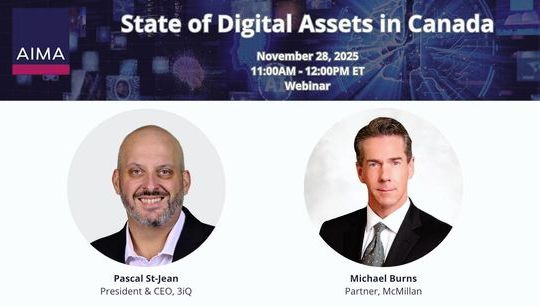Summary: AIMA European Digital Assets Forum 2022
Published: 06 October 2022
Summary: AIMA European Digital Assets Forum 2022
AIMA hosted its inaugural European Digital Assets Forum on 5th October in Zurich, Switzerland. The Forum was buzzing with a full capacity audience of around 150 international delegates from across the alternative investments and digital assets industries coming together to explore the latest frontiers of digital assets investing, including the operational and regulatory challenges that need to be bridged for true institutional adoption.
Key Takeaways
- Parallels drawn to the hedge fund industry in the early 1990s and digital assets today.
- Digital assets are still at an early stage of maturation and adoption.
- Events of the past year have provided the impetus for firms to adopt more sophisticated due diligence and risk management processes.
- Regulatory uncertainty is still cited as being the ultimate hurdle to clear for greater institutional allocation.
- Rule makers increasingly see the value of digital assets to their economies and are starting to pick up the pace on developing clearer guidance/frameworks.
Investor Sentiment and Opportunities
- Reflecting on the current ‘crypto winter’, panellists shared the view that bear markets can be beneficial for entrepreneurs and, going forward, digital assets are likely to be an alternative store of value to hedge inflation.
- Investor appetite for digital assets is growing as infrastructures for custody and trading come in to place and real use cases for digital assets emerge.
- Panellists highlighted KKR providing tokenised access to a portion of one of its funds; the introduction of ‘decentralised science’, which digitises research in the form of intellectual property-NFTs, and Pfizer Ventures’ investment in VitaDAO; and Starbucks launching a Web 3.0-powered NFT model for its loyalty program as cases demonstrating the growing economic interest in digital assets and blockchain.
- Investors are seeking less beta and more alpha extraction, providing an opportunity for hedge funds, and an increase in actively managed funds over exchange-traded funds is anticipated.
- More specialist strategies are emerging to meet the needs of institutional investors, such as DeFi yield-generating strategies and structured products.
- In terms of fund domiciles, Cayman remains a popular location to set up digital assets funds, though Luxembourg and Ireland are on the horizon.
Policy and Regulation
- The last piece of the puzzle for larger regulated institutions to enter the digital assets space and allocate capital is greater regulatory clarity.
- In the EU, the Markets in Crypto Assets (MiCA) Regulation is a matter of “the good, the bad and the ugly”. While it is a step in the right direction and will harmonise regulation across the EU, certain aspects are left out such as NFT regulation and it remains to be seen what will transpire in the Level 2 text, particularly around ESG and related limitations on the proof-of-work consensus mechanism.
- In Asia, beyond China’s ban on crypto mining and crypto-currency transactions, the advancement of CBDCs is welcomed. The recent CBDC trial coordinated by the Bank for International Settlements involving the central banks of China, Hong Kong, Thailand and the United Arab Emirates was seen as a success, facilitating over $22m in cross-border payments and foreign-exchange transactions.
- In the US, the environment is less promising. As the US continues to decipher the SEC and CFTC’s jurisdiction and show hostility towards DeFi, there are concerns that it will lose its status as an incubator for innovation and, being less engaged on the international front, diverge from the EU and internationally.
Operational Risks
- Cybercrime is an inevitability and needs to happen in order for learning lessons and enabling systems to become more robust and for innovation to happen.
- The biggest issue is managing counterparty risk. How do you mitigate this? “Trust no one”. Due diligence is key. Accepting the risk and diversifying exposure is one way to manage counterparty risk for “it’s hard to look a smart contract in the eye”.
- The debate between hardware security modules and multi-party computation is an active one and some firms use a combination of both. In the end, what matters is the outcome and this is unique to each individual fund and goal.
- The insurance market for digital assets is small – less than 5% of digital assets are insured. A more developed regulatory framework would help make insurers more willing to provide insurance capacity in this space.
*****
AIMA will be hosting its AIMA Digital Assets Conference on 11th May, 2023 in New York. AIMA’s digital assets work is focused specifically on the intersection of digital assets and institutional buy-side asset management and encompasses regulatory engagement, thought-leadership initiatives, education and operational guidance. To find out more, please contact Michelle Noyes or James Delaney.









